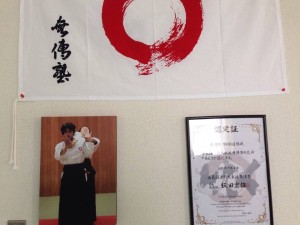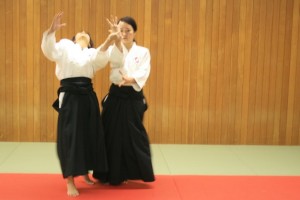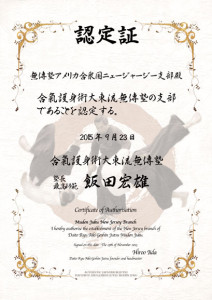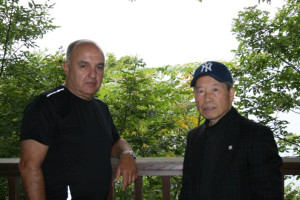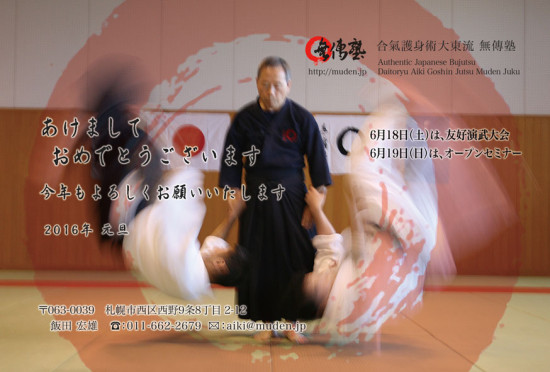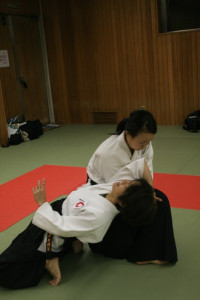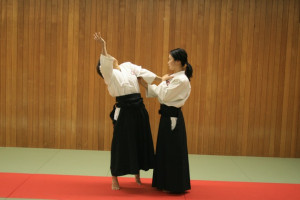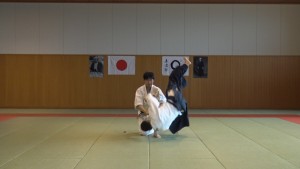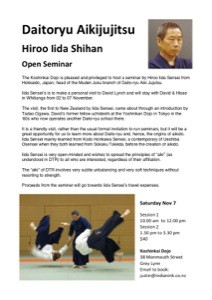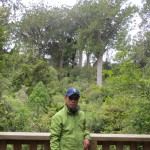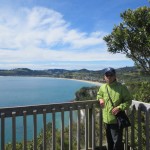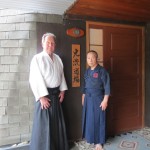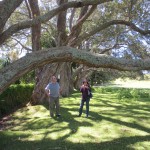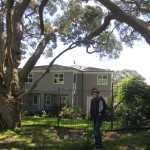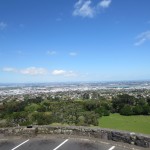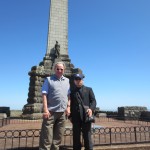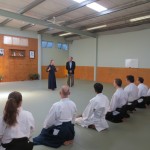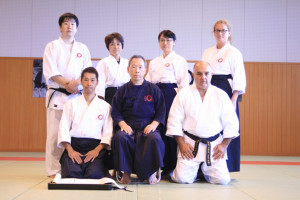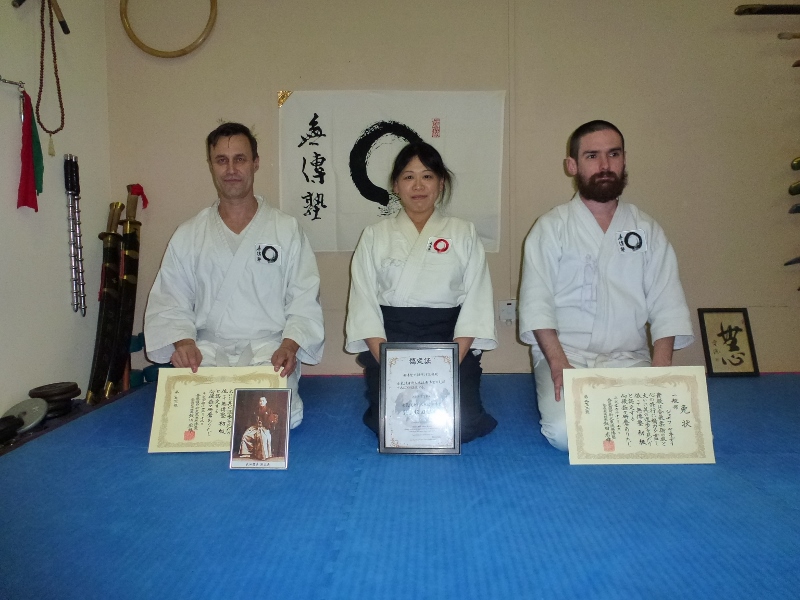
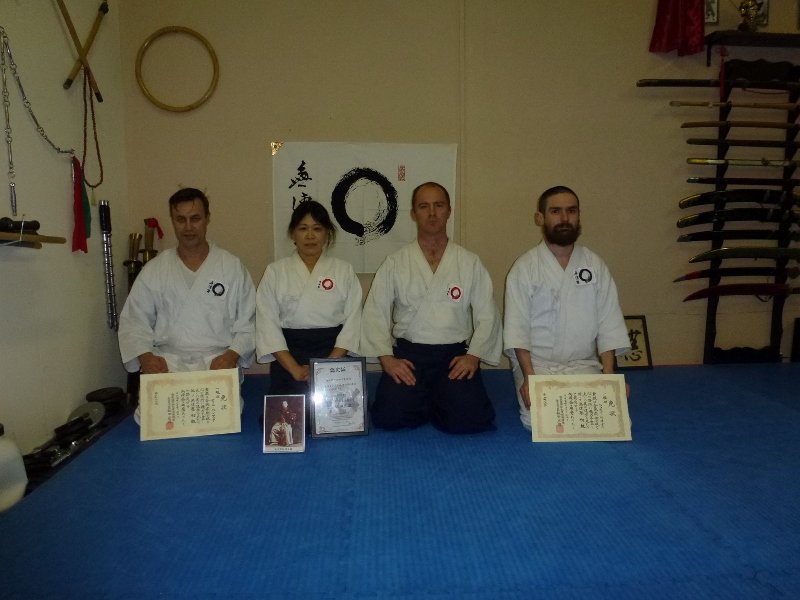
大東流無傳塾アイルランド支部(支部長 オシン・バーク)において
2015年12月13日、審査会が行われました。
アイルランドに無傳塾の小さな花が咲きました。
これからも長く長く咲き続けてください。
Congratulations!
2016年1月13日
無傳塾塾長 飯田宏雄
ジョセフ・ケネディの初審査後のエッセイ(2016年1月)
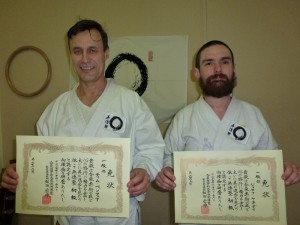
ティム・ペンフェアとジョセフ・ケネディ(右)
私は、約1年半に渡って無傳塾アイルランド支部で稽古をしています。
この稽古を始めてから、体の変化を感じるようになりました。今までと体の使い方が変わって来たのです。姿勢が良くなり、呼吸が楽になり、体や心もリラックスして、頭もすっきりし、これはなぜだろうととても不思議に感じています。
稽古では、“合気”を使う(養う、育てる)ことに集中します。体内の中心からグーッとのびる、目には見えない(小さな、洗練された)動き。無傳塾で習う技は、柔術や合気道などでも見られる技ですが、その完成度、レベルの高さは全然違います。その違いが少しずつ分ってきたところです。(注:ジョセフは合気道の有段者)
大東流・無傳塾は飯田宏雄先生を最高師範として、その師、堀川幸道氏より直伝を受けた大東流の直系である。オシンは北海道・札幌に8年間滞在し、この間飯田師範のもとで修行を積んだ。特に古流を習うのに大事なことは、直伝を受けたものから教えを受け、実際に肌で感じ、それを何度もなぞることだ。
今、オシンはそれをアイルランドで私たちに教えてくれています。
大東流には、“柔術”“合気柔術”“合気の術”と3つのパートがありますが、無傳塾では、“合気の術”に焦点を当てて稽古をします。柔術や、合気柔術では、主に関節を攻めますが、“合気の術”は、体の中心をコントロールして攻めます。
稽古は、“型稽古”と呼ばれるやり方です。これは、ほとんどの日本の古流武道で取り入れられている稽古法です。塾生は、何度も何度も、体が覚えるまで技をなぞり、今稽古していることだけに集中します。
一番の基本技は“合気上げ”です。初めて見たときすごく簡単そうに見えましたが、実際にやってみていかにこの技がむずかしく、全ての技のもとになっているということが、いま分ります。塾生はこの“型稽古”で何度も何度もこの技を練習し、“合気上げ”を習得することで、合気の体を作り、技を磨きます。
無傳塾での稽古は素晴らしい(値打ちのある)ものです。
特に、欧米では心と体は別々のものと考える習慣があり、まず自分の頭で理解しないと納得できず、慣れない稽古法でストレスをためる人が多いのですが、型稽古を受け入れることで
心が落ち着き、自分の体(の中)を注意深く感じることが出来るようになってきました。
いつも、稽古のあとはリラックスした気分になり、同時に元気がみなぎる感じがします。
また、稽古を通して、日本の文化や考え方なども学んでいると思います。
いつも素晴らしい稽古をしてくれるオシンに感謝します。
(日本語訳:バーク 恵)
▼ English
I have trained with Oisin and Megumi Bourke for one and a half years and thus far the experience has been deeply fascinating. Also rewarding, I am learning to use my body in a more relaxed manner, benefiting my posture, my breathing and mental composure. The focus of the training is to use ‘Aiki’. Subtle movements of extension emanating from the center. The techniques used can be seen in variation in many systems of Jujutsu and Aikido. However the focus and level of control is different. It is something that must be felt to even begin to be understood.
The Daito Ryu of the Muden Juku is headed by Hiroo Iida, a direct student of Kodo Horikawa from whom he received the rank of Shihan. Oisin spent 8 years living in Sopporo training under Iida Sensei during which time he studied with the group and privately, a important part of training as direct transmission is the only way for the school to stay alive. For Oisin passing on what he learnt accurately is of vital importance.
The training of Daito Ryu is divided into three parts. Jujutsu, Aiki Jujutsu and Aiki no Jutsu. The focus of the Muden Juku is Aiki no Jutsu, the most subtle aspect of the School, although we also practice occasionally the Aikijujutsu techniques to better understand specific principles. In Aiki no Jutsu the goal is control via the center, whereas in Aikijujutsu you usually control through a joint manipulation.
The training method is Katageiko. This term is common to most traditional Japanese Budo. The student repeats an exercise until it is time to move on, keeping their mind in the present and thus in connection with their body. The first Kihon practiced is Aiki Age. Pronounced A-gai. At a glance it appears very simple but with persistent practice its complexity becomes apparent. A lot of time is given to this one technique as it conditions the student for the entire practice and in this way the individual becomes a part of the Ryu (school). As the student becomes more conditioned by the practice, the body habits and reflexes improve accordingly and thus this connection to the Ryu deepens.
The practice of the Muden Juku is of great value, especially in our western cultures where often people think of body and mind as two separate things often even in opposition. Excessive intellectualising is counterproductive and frustrating. However with the mind calm the subtlety of the Art can be more readily perceived. I often feel both more relaxed and energised after the training. Besides from this the insight into Japanese Culture and Budo derived from these classes is must insightful.
Thank You to Oisin and Megumi for all the time and patience.

